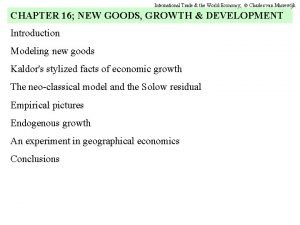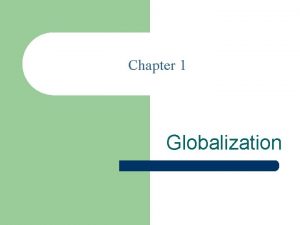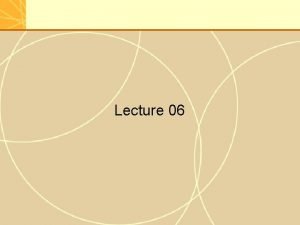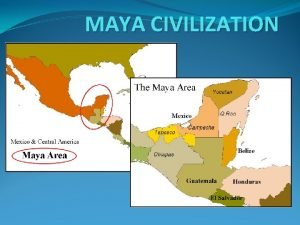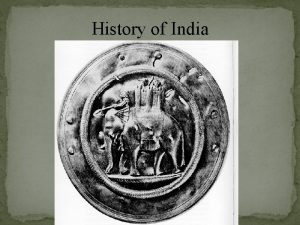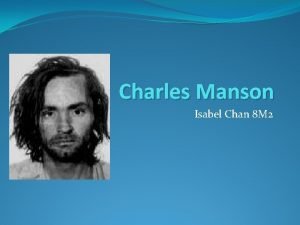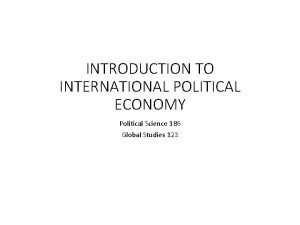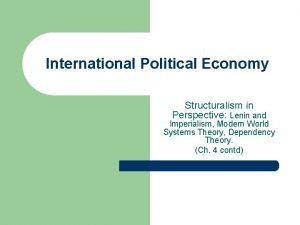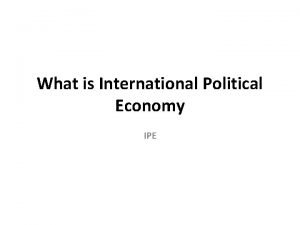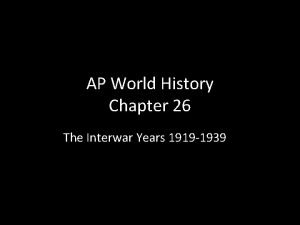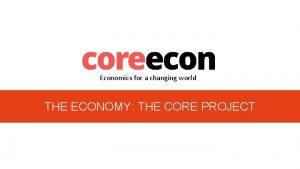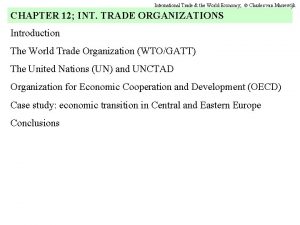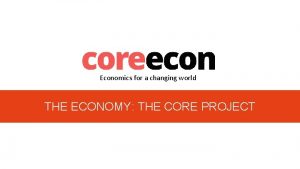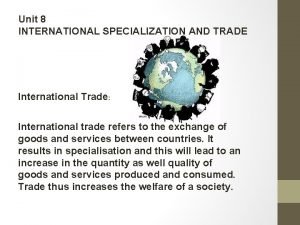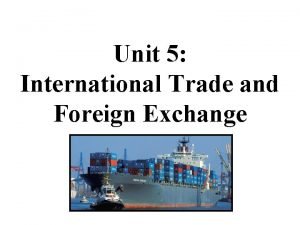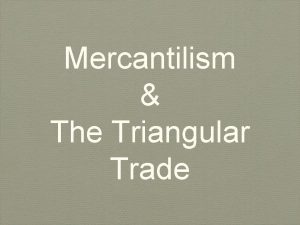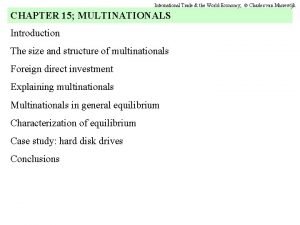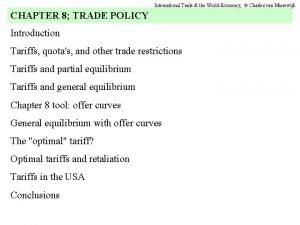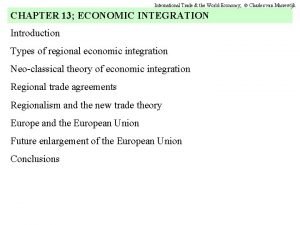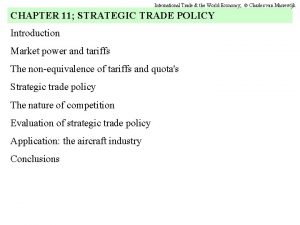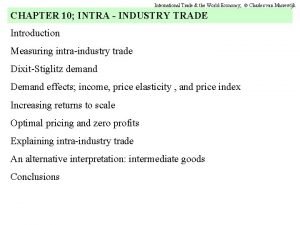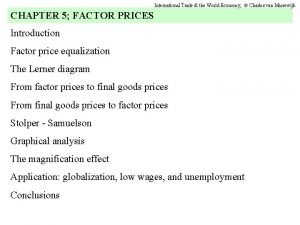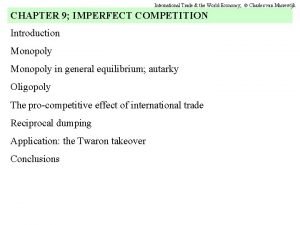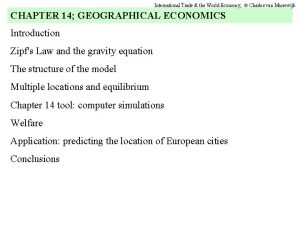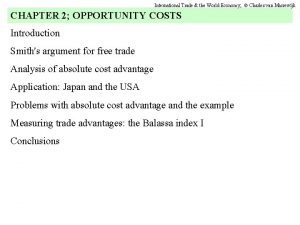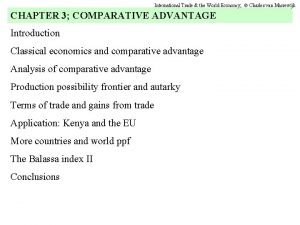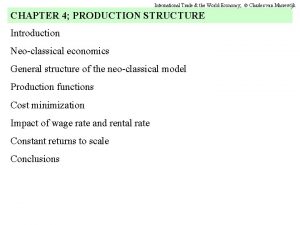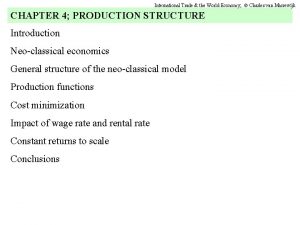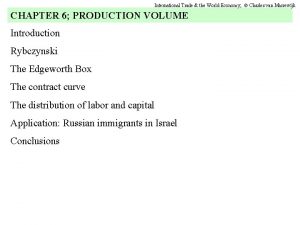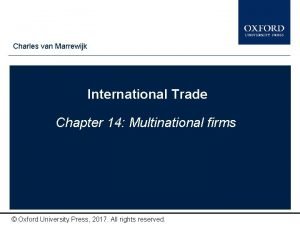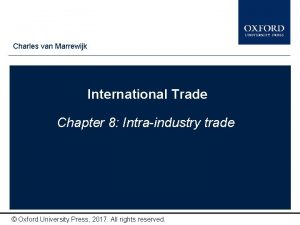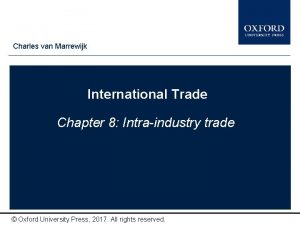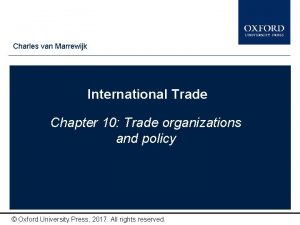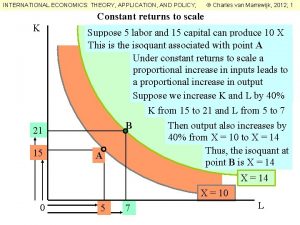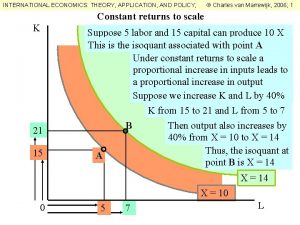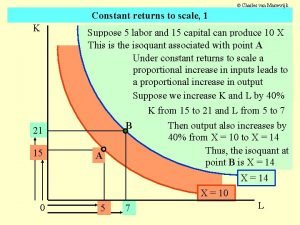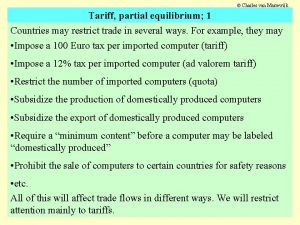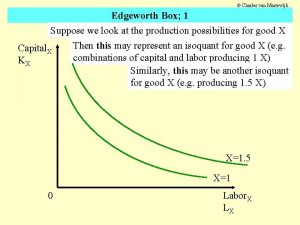International Trade the World Economy Charles van Marrewijk



























- Slides: 27

International Trade & the World Economy; Charles van Marrewijk CHAPTER 7; FACTOR ABUNDANCE Introduction Heckscher - Ohlin Demand The production possibility frontier Structure of the equilibrium Autarky equilibrium International trade equilibrium Application: the Summers-Heston data The case of the missing trade Conclusions


International Trade & the World Economy; Charles van Marrewijk CHAPTER 7; FACTOR ABUNDANCE Introduction Heckscher - Ohlin Demand The production possibility frontier Structure of the equilibrium Autarky equilibrium International trade equilibrium Application: the Summers-Heston data The case of the missing trade Conclusions

International Trade & the World Economy; Charles van Marrewijk Introduction Bertil Ohlin (1899 -1979)

International Trade & the World Economy; Charles van Marrewijk CHAPTER 7; FACTOR ABUNDANCE Introduction Heckscher - Ohlin Demand The production possibility frontier Structure of the equilibrium Autarky equilibrium International trade equilibrium Application: the Summers-Heston data The case of the missing trade Conclusions

International Trade & the World Economy; Charles van Marrewijk Heckscher - Ohlin Heckscher-Ohlin proposition In a neo-classical framework with 2 final goods, 2 factors of production, and 2 countries which have identical homothetic tastes, a country will export the good which intensively uses the relatively abundant factor of production. If the production of manufactures is capital intensive and Austria is capital abundant, Austria will export manufactures and import food.

International Trade & the World Economy; Charles van Marrewijk CHAPTER 7; FACTOR ABUNDANCE Introduction Heckscher - Ohlin Demand The production possibility frontier Structure of the equilibrium Autarky equilibrium International trade equilibrium Application: the Summers-Heston data The case of the missing trade Conclusions

International Trade & the World Economy; Charles van Marrewijk Demand All previous neo-classical results depend only on the supply side, since we have to specify the demand side to make conclusions about trade flows. Maximizing the utility function subject to a standard budget contraint implies that consumers will spent a fraction of their income on manufactures (quite similar to cost minimization problem for producers)

International Trade & the World Economy; Charles van Marrewijk CHAPTER 7; FACTOR ABUNDANCE Introduction Heckscher - Ohlin Demand The production possibility frontier Structure of the equilibrium Autarky equilibrium International trade equilibrium Application: the Summers-Heston data The case of the missing trade Conclusions

International Trade & the World Economy; Charles van Marrewijk The production possibility frontier With crs and 2 factors of production the ppf is concave to the origin

International Trade & the World Economy; Charles van Marrewijk The production possibility frontier The curvature of the ppf depends on the difference in capital intensity for the production of food and manufactures

International Trade & the World Economy; Charles van Marrewijk The production possibility frontier Increase in capital stock leads to outward shift of ppf biased in the direction of capital intensive manufactures; tangency points at constant prices is straight line (Ryb)

International Trade & the World Economy; Charles van Marrewijk CHAPTER 7; FACTOR ABUNDANCE Introduction Heckscher - Ohlin Demand The production possibility frontier Structure of the equilibrium Autarky equilibrium International trade equilibrium Application: the Summers-Heston data The case of the missing trade Conclusions

International Trade & the World Economy; Charles van Marrewijk Structure of the equilibrium

International Trade & the World Economy; Charles van Marrewijk CHAPTER 7; FACTOR ABUNDANCE Introduction Heckscher - Ohlin Demand The production possibility frontier Structure of the equilibrium Autarky equilibrium International trade equilibrium Application: the Summers-Heston data The case of the missing trade Conclusions

International Trade & the World Economy; Charles van Marrewijk Autarky equilibrium

International Trade & the World Economy; Charles van Marrewijk Autarky equilibrium Autarky in 2 countries (A and B) Capital abundant A produces relatively more capital intensive manufactures at relatively lower price

International Trade & the World Economy; Charles van Marrewijk CHAPTER 7; FACTOR ABUNDANCE Introduction Heckscher - Ohlin Demand The production possibility frontier Structure of the equilibrium Autarky equilibrium International trade equilibrium Application: the Summers-Heston data The case of the missing trade Conclusions

International trade equilibrium International Trade & the World Economy; Charles van Marrewijk For A price of manufactures rises: capital abundant A produces even more capital intensive manufactures and exports these in exchange for food

International Trade & the World Economy; Charles van Marrewijk CHAPTER 7; FACTOR ABUNDANCE Introduction Heckscher - Ohlin Demand The production possibility frontier Structure of the equilibrium Autarky equilibrium International trade equilibrium Application: the Summers-Heston data The case of the missing trade Conclusions

International Trade & the World Economy; Charles van Marrewijk Application: the Summers-Heston data Hypothetical production/worker in autarky using Summers-Heston data

International Trade & the World Economy; Charles van Marrewijk Application: the Summers-Heston data Hypothetical production/worker in free trade w. Summers-Heston data

International Trade & the World Economy; Charles van Marrewijk CHAPTER 7; FACTOR ABUNDANCE Introduction Heckscher - Ohlin Demand The production possibility frontier Structure of the equilibrium Autarky equilibrium International trade equilibrium Application: the Summers-Heston data The case of the missing trade Conclusions

International Trade & the World Economy; Charles van Marrewijk The case of the missing trade First important empirical study (1956) leads to ‘Leontief paradox’: supposedly capital abundant USA imports capital intensive goods? Possible explanations: demand bias, factor-intensity reversal, restrictiveness of 2 2 2 framework. Later studies, e. g. Bowen, Leamer, and Sveikauskas (1987), analyze more goods, more factors, more countries, as did Trefler (1995) who • finds modest support for neo-classical trade model (about 71%) • shows that factor service trade is smaller than factor endowments prediction (case of missing trade) • support increases if technological differences (part I of the book) are taken into consideration (to about 78%) • support increases if domestic demand bias is taken into consideration (to about 87%) • with neo-classical model, different technology, and demand bias about 93% of international trade flows can be explained.

International Trade & the World Economy; Charles van Marrewijk CHAPTER 7; FACTOR ABUNDANCE Introduction Heckscher - Ohlin Demand The production possibility frontier Structure of the equilibrium Autarky equilibrium International trade equilibrium Application: the Summers-Heston data The case of the missing trade Conclusions

International Trade & the World Economy; Charles van Marrewijk Conclusions Neo-classical model: • assumes identical homothetic preferences; neutralize demand effects • countries with high capital-labor ratio have high wage-rental ratio in autarky and low relative price of capital intensive good • free trade equalizes final goods prices (and thus factor prices; FPE) • capital abundant country exports capital intensive good (HOS) • free trade increases production, global efficiency, and welfare • extended version of the model performs reasonably well empirically • technology intensive manufacturing exports mainly in OECD countries (next slide)

International Trade & the World Economy; Charles van Marrewijk Conclusions Technology intensive man. ; share of exports (%), 1998; Source: ITC
 Charles van marrewijk
Charles van marrewijk Athenian economy vs sparta economy
Athenian economy vs sparta economy The changing world output and world trade picture
The changing world output and world trade picture The changing world output and world trade picture
The changing world output and world trade picture Maya timeline
Maya timeline Indus valley civilization trade and economy
Indus valley civilization trade and economy Right and responsibilities
Right and responsibilities Ancient india natural resources
Ancient india natural resources Charles manson charles luther manson
Charles manson charles luther manson Developing world definition
Developing world definition Structuralism in international political economy
Structuralism in international political economy Mercantilism theory of international trade
Mercantilism theory of international trade Trade diversion and trade creation
Trade diversion and trade creation Trade diversion and trade creation
Trade diversion and trade creation Trade diversion and trade creation
Trade diversion and trade creation The trade in the trade-to-gdp ratio
The trade in the trade-to-gdp ratio Fair trade not free trade
Fair trade not free trade Trade diversion and trade creation
Trade diversion and trade creation Liner trade and tramp trade
Liner trade and tramp trade Triangular trade definition
Triangular trade definition Fascist corporatist economy ap world
Fascist corporatist economy ap world The economy economics for a changing world
The economy economics for a changing world World-economy
World-economy Answert the public
Answert the public Unit 8
Unit 8 International trade and foreign exchange
International trade and foreign exchange Mercantilism
Mercantilism Materi current theory of international trade
Materi current theory of international trade
